 Thanks: 0
Thanks: 0
 Likes: 0
Likes: 0
 Needs Pictures: 0
Needs Pictures: 0
 Picture(s) thanks: 0
Picture(s) thanks: 0
Results 16 to 30 of 42
-
23rd May 2011, 12:19 AM #16
 SENIOR MEMBER
SENIOR MEMBER











- Join Date
- Oct 2008
- Location
- N.W.Tasmania
- Posts
- 703

Hi All,
the high cost of cast iron stock would seem to be reason enough to home brew some. Not a trivial exercise to be sure, it would be easy to stuff up by choosing the wrong scrap to melt, but some of those prices are pretty hefty for not that much material. I wonder how many truck brake drums or engine blocks or old crankshafts it would take to melt down to make those sized slabs for machining.
Ray you would seem to have too much zinc for a true gunmetal, although one of my main sources of info is AWOL ATM. Machinery's Handbook has all the copper alloy numbers as Cxxxxx, so I am assuming that your 360 is the new C36000, which is constituted of
Cu 61.5%
Pb 3.1% and
Zn 35.4%,
If so then you could get back on rack by adding a large amount of Cu, (which you have done) to bring the proportion of Zn down to say 2%, but then you would need to add a fair bit of pure Sn so that the solder didn't contribute too much lead.
Having said all that, your particular alloy will most likely work out just fine for this application. and give you as well as the rest of us plenty of pleasure as we look over the photos you will post in the near future. How were your egg and bacon sandwiches? I hope that the rain didn't make them too soggy.
Pipeclay - how much per kilo, what do you use exactly and where do you get it, I can almost hear the masses calling out. Have you uploaded photos in the past of your casting exploits, I for one would be most interested. It's getting late,so I/ll catch you all down the track, Nitey nite,
Rob
-
23rd May 2011 12:19 AM # ADSGoogle Adsense Advertisement
- Join Date
- Always
- Location
- Advertising world
- Posts
- Many
-
23rd May 2011, 12:31 AM #17
 GOLD MEMBER
GOLD MEMBER











- Join Date
- Jul 2010
- Location
- Melbourne
- Posts
- 7,775

Rob,
I'd think it would be easier to get hold of rotors. Brake places may even give them away.
Ray,
Isn't cast bar costly because it has to be cast in the size required and not hot worked to size?(as I understand it cast is now made out of recycled steel, virgin cast is made into steel)
Stuart
-
23rd May 2011, 01:32 AM #18

Hi Rob,
We ratios we used were 110g of alloy 360, 70g of 40/60 Pb/Sn solder, and 550g Copper
That ended up giving us 85% Cu, 5.3% Zn, 5.7% Sn, 4.3% Pb which is pretty close to gunmetal, we were pretty limited in the sense that we had to work with just the materials we had to hand.
The procedure (for those interested) is to reverse the melting point order, so you melt the copper first, then add brass to the molten copper, then finally add the solder last.
Wasn't too impressed with the pouring characteristics although the finished result came out pretty good, it seemed to generate a lot of slag.. Although reading about others casting gunmetal that seems a common enough observation.
Good question Stuart, I don't know, I'm looking for a source of cast iron at the moment, but there's no way I'd pay those prices. I'm trying to find out more about brake drums... But I'll see what the local scrap dealer has on offer. Originally Posted by Stuart
Originally Posted by Stuart
Regards
Ray
-
23rd May 2011, 09:13 AM #19
 Pink 10EE owner
Pink 10EE owner











- Join Date
- Aug 2008
- Location
- near Rockhampton
- Posts
- 4,304

The cast iron bar is continuously cast, that is why there are a limited number of sizes available in square/rectangular..
Round cast iron bar is widely available..I keep small amounts on hand for various uses...
I think the problem with perceived cost is this.... We are so used to household consumer items being so cheap as they are made in some third world country that when it comes to Australian made items we have to pay full price and we baulk at it...
-
23rd May 2011, 10:51 AM #20
 GOLD MEMBER
GOLD MEMBER











- Join Date
- Jul 2010
- Location
- Melbourne
- Posts
- 7,775

Ray,
If you're talking about getting brake parts. It would be better to go to the local mechanic or brake place. The ones I know at best have the scrap picked up for free. Some used to cart it down to the scrap man. So it shouldn't be hard to get hold of some. I could get you some but its a little far to come for a few rotors. I plan on getting a few to play with as rotors should be extremely well aged(I think?) shame there aren't thicker sections.
.RC.
Cast bar seems to be far more costly than steel bar(although I cant find prices for an example). I think its a slower process. Maybe there isn't much competition either?
Stuart
-
23rd May 2011, 03:42 PM #21

Hi .RC,
I suspect we are talking from different perspectives here, I'm looking for cast iron scrap to have a play around with casting, current price for cast iron scrap is $350/tonne for top grade clean cast, (varies a lot depending on many factors) but let's triple that price for small quantities of good quality material suitable for casting, and call it a dollar per kilo.
You piece of 250x30x80 works out to roughly 4.2 kg, so scrap value would be ~$5, however as a finished product ready for subsequent machining and taking into account the costs of stocking the product and postage and suitable margin for the dealer, $88 might be a reasonable price.
But from my perspective, that's too expensive to use a feedstock for the furnace. $5 yes, but $88 no way I'd melt that down, as stock for machining (which is what I assume you are doing) no problem.
Regards
Ray
-
23rd May 2011, 05:54 PM #22

Hi Stuart,
Got some rotors and drums from the local brake repair place, they have a skip out the back full of drums and rotors... Take as much as you like, for a donation to the christmas club fund.
Next step is to see if it's any good for casting, I do know that the guy who does the cast iron reproduction lamposts you see now and then, uses old brake drums. I'll see how it goes. I've got to finish the new burner first.
Regards
Ray
-
23rd May 2011, 07:14 PM #23
 SENIOR MEMBER
SENIOR MEMBER











- Join Date
- Oct 2008
- Location
- N.W.Tasmania
- Posts
- 703

G'day All,
Ray, I imagine that brake parts would be SG iron, and if it remained so during the remelt and casting, that would be what most of us would want for our projects. It is the toughest form, but easily machinable, unlike say the white iron which is very much harder, and most likely a bit of a handful to machine, let alone tap a thread into. Since most of our projects won't involve things like slurry pump bowls or impellers, where wear resistance is of major concern, the SG type iron would most often be the material of choice I would think. Your source sounds just what you want, a win win for you and your brake man.
It kind of makes me nearly weep, because in a previous life, I worked at a small iron ore mine, in the maintenance section, and saw large amounts of excellent scrap just get dumped, not even sold for scrap. These included brake drums weighing around 300Kg, worn bronze bushes, which had been air-arced out of face shovel track frames, not sure what they would have weighed, but they were about 250-300 mm in dia., and about 3-400 mm long with a wall thickness of 25 - 30 mm. Also bronze gear wheels from a worm wheel gear-box, about 500 mm dia, and 125 mm thick on the rim and around 60 mm on the inner flange. The gears sat around for months, but eventually went to the dump in pre directors visit clean-ups! Just to really rub it in , I have looked up the metal prices on the metal exchange, and will paste them in below, but keep in mind this is close to your price if you are buying boat loads of the stuff, not a few Kgs. With Tin at over 27.7K US$ per tonne, you can see why bronze is much dearer than brass.
Gold 1515.49
Palladium 733.99
Platinum 1768.49
Silver 35.22 +0.17
Base Metals
Aluminium 2489.5 USD/tn
Copper 9049.75 USD/tn
Lead 2518.0 USD/tn
Nickel 23525.0 USD/tn
Tin 27702.0 USD/tn
Zinc 2130.75 USD/tn Market Close / May 20
Stuart were you thinking that the rotors would be more plentiful, or would the material be more desirable for some reason. I would have thought, (with no real knowledge of the fact), that they both would be SG iron, but perhaps I am making an incorrect assumption here. With the rotors, you would need to make sure that the bearings had been removed, otherwise you'd change the recipe a bit, but an advantage may be that they would be easier to break up a bit to fit in the furnace for the melt.
Rob
-
23rd May 2011, 08:05 PM #24
 SENIOR MEMBER
SENIOR MEMBER











- Join Date
- Jun 2004
- Location
- Kyabram. Vic
- Posts
- 826

I have seen castings made from nodular iron crankshafts. Very nice casting.
What about old engine blocks/heads or cast iron baths?
Ken
-
23rd May 2011, 09:38 PM #25
 GOLD MEMBER
GOLD MEMBER











- Join Date
- Jul 2010
- Location
- Melbourne
- Posts
- 7,775

Rob,
Very informative post, thanks.
I only suggested rotors as I think most people will find them easier to get hold of(some rotors are unmachinable!!(that's size wise not material wise). Would bearing shells melt at case iron temps?
Ray,
Good news, its amazing what a little lubrication will do.
Stuart
-
23rd May 2011, 10:52 PM #26

Hi Rob,
That's interesting, certainly encouraging. I'm on a steep learning curve with cast iron types and properties and how to cast them.
I'm being guided by the Stephen Chastain book, the procedure he describes is to load the crucible with alternate layers of charcoal and cast iron (broken up into walnut sized pieces) and also to put in a handfull of soda ash. And then cover the crucible. I'm guessing here but I imagine the charcoal is to soak up any oxygen which if allowed to come in contact with the molten cast iron would remove carbon from the cast iron, effectively turning it into wrought iron, or at least changing it's properties somewhat.
There are a lot of other variables, but keeping oxygen out is a high priority.
The brake drums and rotors seem to break up nicely with a little persuasion from a sledge hammer.
Regards
Ray
-
24th May 2011, 12:11 AM #27
 SENIOR MEMBER
SENIOR MEMBER











- Join Date
- Oct 2008
- Location
- N.W.Tasmania
- Posts
- 703

G'day Ray and All,
Ray , I have done quite a bit of reading, but NO doing, so take what you will from my ramblings, I am no expert, to be sure.
I am not sure of the reason for the layers of charcoal, it may be to keep the carbon content up, but I'm not sure how much you would lose without it during the melt, because as I understand it, when they make steel, they blast oxygen, not just air, through molten pig-iron to burn the carbon out, - if that is right, you wouldn't think that just melting some walnut sized C/I would take out too much Carbon. I have found an interesting site, and will post the link below, where they say that to cast SG iron, that magnesium is added to the molten iron just before casting. I don't think that my arms would be long enough to do that in the back-yard situation. I have visions of something like the Space Shuttle taking off, exciting but not a good look in the suburban back yard!
I have seen reference to S.Chastains book, but have not had the chance to read it at all, but quite a few people seem to recommend it, so it's likely that he is well on the money.
I know what you mean by a steep learning curve, up till an hour ago, I thought ductile iron and malleable iron were one and the same!
Those brake drums and rotors would be much easier I'm tipping, to break up with a sledge hammer than the drum off a dump truck that I mentioned earlier. I wish that I had all that brass and bronze though. There are mines within an hour or two from me where they mine tin, and I had wondered if it would be possible to get some concentrate to play with, but with the price where it is I'd fell a touch nervous even in expressing an interest in buying some. I'm not even certain that it is in a metallic form, I tend to think that it is, by all accounts it's heavy as hell.
And Stuart, you're right, the iron melts at a lower temp than the bearing materials (1150 -1200℃ compared to 1425℃) but you would possibly be better off in our situation not taking the chance as our controls aren't industrial strength exactly. Nice tool holder by the way Nighty nite All,
Nighty nite All,
Rob
Cast Iron
-
24th May 2011, 12:29 AM #28
 GOLD MEMBER
GOLD MEMBER











- Join Date
- Jul 2010
- Location
- Melbourne
- Posts
- 7,775

Ray,
I'd say "bearing shells make handy parallels". But as you have a surface grinder, what would you care? hehe
hehe
Would be nice to know more about the cast used in rotors but I'm guessing all the manufactures have there own "secret" recipe.
Stuart
-
24th May 2011, 09:06 PM #29

Yep... It's been getting a work out doing some plane bodies, don't know how I ever lived without it..

Here's a few pictures from the casting on sunday, some pictures by Peter McBride, and some by Matty.
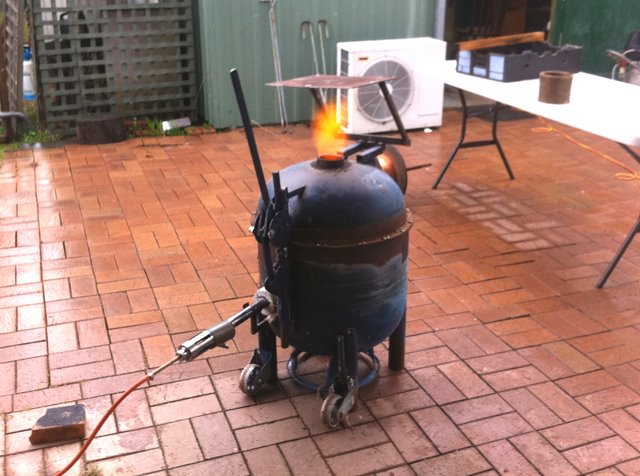
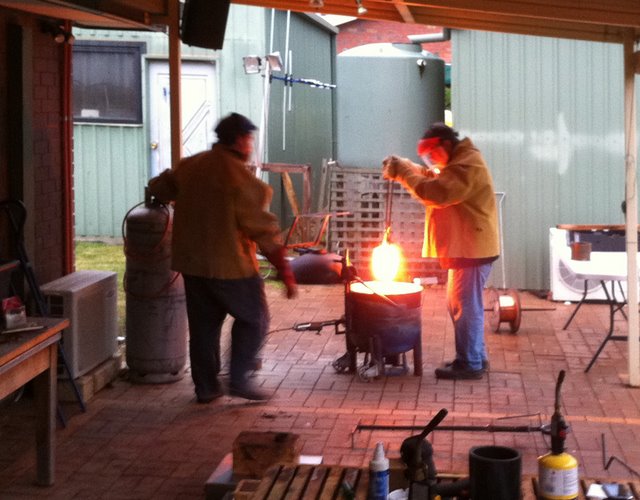
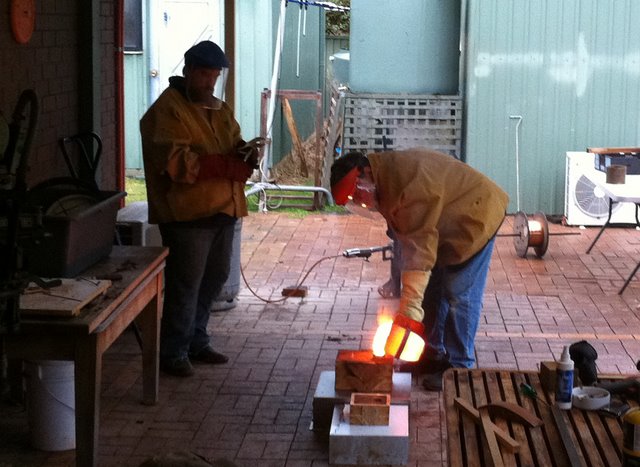
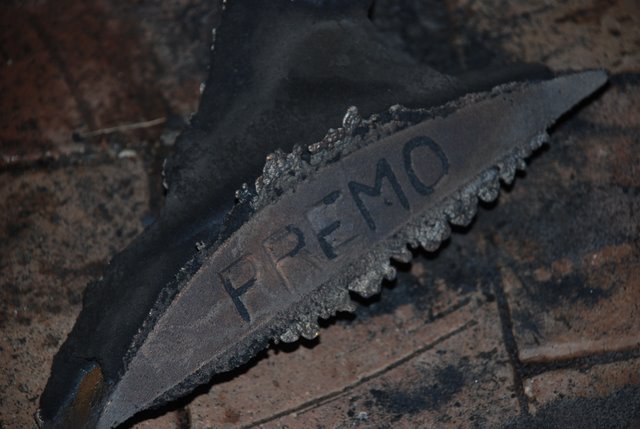
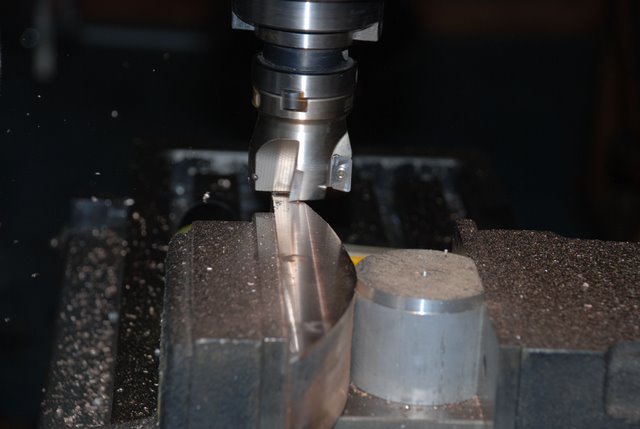
The part is for a Premo shaper that Matty owns, I think he is going to post something on the owwm forum.
Peter carved a pattern for a lever cap, (beautiful job in no time flat I should add), and we cast a couple of lever caps as well.
The top picture shows the hastily welded rain shield, that I knocked up, just in case it started raining when the furnace was running. Water doesn't mix well with molten bronze. Of course I realized later, it would also be perfect for a sausage sizzle while doing a pour..
Regards
Ray
-
24th May 2011, 11:02 PM #30
 GOLD MEMBER
GOLD MEMBER











- Join Date
- Jul 2010
- Location
- Melbourne
- Posts
- 7,775

Ray,
Looks good.
Shaper as in a "real" shaper? or some sort of wood working thing? lol
Have you ever thought about adding some sort of intake air preheating? Its not like you dont have plenty of waste heat.
Stuart
Similar Threads
-
Melbourne Foundry Suppliers
By RayG in forum THE FOUNDRYReplies: 55Last Post: 28th April 2012, 11:41 PM -
Foundry supplies around Perth?
By Darce in forum METALWORK FORUMReplies: 4Last Post: 13th February 2011, 03:08 PM -
The Charcoal Foundry
By silentC in forum THE FOUNDRYReplies: 63Last Post: 5th September 2009, 10:44 PM -
Backyard Foundry
By InkSpot in forum METALWORK FORUMReplies: 3Last Post: 10th February 2008, 07:40 PM -
Foundry near Tenterfield NSW
By DaveWhitla in forum BOAT RESOURCES / PRODUCT SEARCHReplies: 2Last Post: 11th January 2008, 10:40 AM






